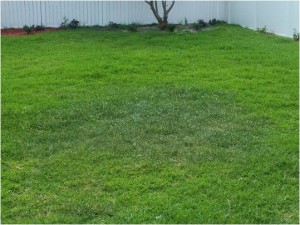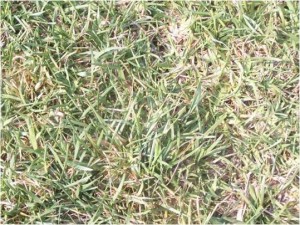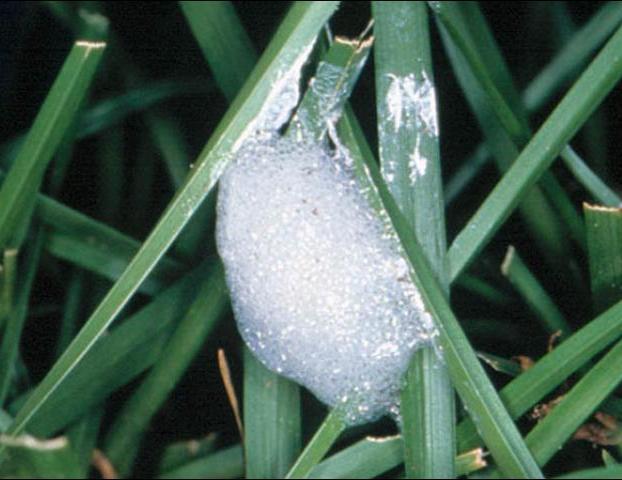
by Blake Thaxton | Jun 12, 2013

Credit: Lyle Buss, University of Florida
In recent weeks Spittlebugs have been found everywhere in the western parts of the panhandle. Spittlebugs are the little black and orange insects you find everywhere in early June. The adult spittlebug is about 1/4 inch long and has two orange lines across its back. You may notice them flying on you while you mow the lawn.
The immature spittlebugs called nymphs, are usually found in a foamy white mass that characterizes the name of the insect. The spittle mass is for protection of the nymphs from predators and desiccation.

Credit: E. A. Buss, University of Florida
The spittlebug can cause injury to ornamental turfs and other ornamental plants. The adults feed on turf, centipede is the turf of choice. When feeding, the insect injects a toxin into the leaf blade with its piercing/sucking mouthparts. The pierced leaf blade will take on purple, white, or yellow stripes along the turfgrass blade vertically. Heavy infestations are best identified by a combinations of finding the injury, spittle masses, and large numbers of adults present.

Credit: Larry Williams, UF/IFAS
Recently spittlebugs have been spotted across many counties in the panhandle. Many have brought them to the extension offices for identification and treatment recommendations. Identification is the correct first step when having an IPM or Integrated Pest Management approach to insect control.
Bryan Unruh Ph.D is the UF/IFAS turf specialist stationed in Jay at the West Florida Research and Education Center. Dr. Unruh posted on Facebook about Spittlebugs and the post read:
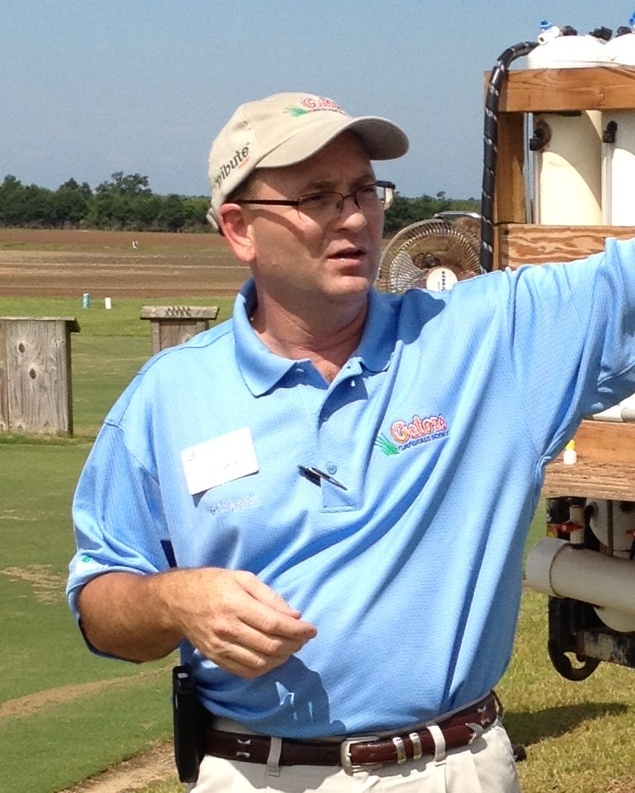
Dr. Bryan Unruh, UF/IFAS
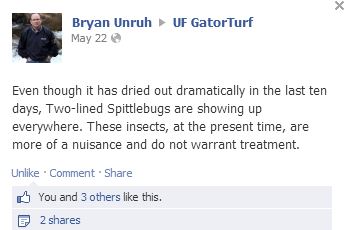
Sticking to an IPM plan, at this current date spittlebug damage has not met the aesthetic threshold to put a control plan in place. Once the threshold has been met then cultural, mechanical, an chemical techniques need to be discussed to best take care of the issue. Since Dr. Unruh commented on spittlebugs there has been a dramatic increase in rainfall, so we can expect for the spittlebugs, to stay around a while longer. If you think you have an infestation that warrants treatment, call your local extension agent for treatment options.
by | Jun 4, 2013
Proper watering can make the difference between life and death to newly planted lawns, trees, shrubs, bedding plants, vegetable transplants and ground covers during the summer.
Because their roots have not had time to grow out into the surrounding soil, these plants do not yet have well-established root systems. With their root systems still limited to a relatively small area of soil, they are especially vulnerable to drought stress.
Trees
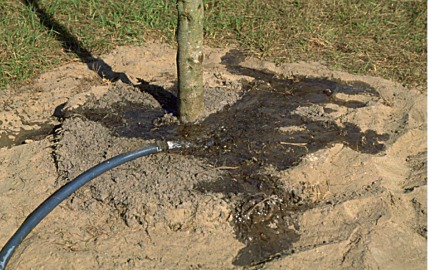 The first summer after planting is the most critical time for newly planted trees, and proper watering plays a major role in whether or not they survive – or how well they survive. Here are some effective watering techniques for trees.
The first summer after planting is the most critical time for newly planted trees, and proper watering plays a major role in whether or not they survive – or how well they survive. Here are some effective watering techniques for trees.
One good method is to turn a hose on trickle, lay the end on top of the ground within 6 inches of the trunk of the tree and let the water trickle for about 20 minutes to 30 minutes. Or build a 4-inch high levee out of soil around the edge of the area dug up to plant the tree. Fill this area with water and let it slowly seep into the root zone.
I’ve found one of the best methods is to use a heated metal skewer or ice pick to pierce five to 10 holes through the bottom of a 5-gallon paint bucket or similar container. Make all the holes on one side. Place the bucket next to the tree trunk with the holes closest to the trunk. Fill up the container, and the water will slowly seep through the holes, providing excellent irrigation. If you want, you can spray paint the outside of the bucket dark green to make it less noticeable.
Use any of these techniques during hot weather whenever seven to 10 days pass without substantial rainfall. Continue to water twice a week until a good rain occurs. Drought-stressed trees may experience wilting, leaf drop, yellow or brown leaves, scorched leaf edges or even death.
Shrubs
Newly planted shrubs will need to be monitored more carefully and watered more frequently than established shrubs. Water with soaker hoses or sprinklers left on long enough for the water to penetrate at least 4 to 6 inches into the soil.
Keep in mind that all of a newly planted shrub’s roots are in a small area – about the size of the pot the shrub was growing in before planting. This is especially true for shrubs planted after March, since they have had little time to grow roots into the surrounding soil. A shrub can use up all the water in its root ball and become drought stressed even though the soil in the bed outside of the root ball is moist. So when checking the soil moisture in the bed, always be sure to stick your fingers right around the shrubs themselves.
Lawns
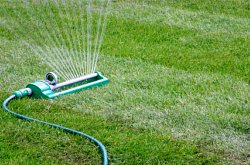 Now is a great time to lay sod to install a new lawn or repair an established one. But keep in mind that newly laid sod needs special attention to watering.
Now is a great time to lay sod to install a new lawn or repair an established one. But keep in mind that newly laid sod needs special attention to watering.
Water newly laid sod for about 15 to 20 minutes every day for the first seven to 10 days. Then water for about 30 minutes every other day for another seven to 10 days. After that, irrigate the lawn thoroughly once or twice a week, as needed, to encourage the roots to grow deep into the soil.
Do not water every day for more than 10 days or you may encourage fungus diseases. And, of course, there is no need to water if adequate rainfall occurs.
Seeds
Water seeded areas (vegetable seeds, flower seeds or lawn seeds) lightly by hand or with sprinklers every day until the seeds germinate and start to grow. It is critical for the soil to stay moist during germination.
Once the seeds come up, water more thoroughly less often to encourage the roots to grow deep into the soil. As the seedlings become established, water normally as needed.
Containers
 Watering plants in containers outside is a constant job during the summer. It is typical to water every day, even twice a day, when weather is hot and dry. Keep this in mind when considering how many outside container plants you can maintain.
Watering plants in containers outside is a constant job during the summer. It is typical to water every day, even twice a day, when weather is hot and dry. Keep this in mind when considering how many outside container plants you can maintain.
How often you have to water container plants is influenced by temperature, pot size, the type of potting mix, the drought tolerance of a plant, whether a plant is in sun or shade and how pot bound a plant is. Plants need to be watered more frequently when it is hot, if the containers are small, if a light potting mix is used, when plants are in a sunny location and when plants are pot-bound. In addition, clay pots tend to dry out faster than plastic or glazed ceramic pots.
To reduce the amount of watering you have to do, use larger rather than smaller pots, choose a potting mix that retains more water (it must still be fast draining, however), repot pot-bound plants into larger containers, use plastic pots and, if practical, move the plants into somewhat shadier conditions.
Potting mixes will retain more water with the addition of hydrophilic polymers. These gelatin-like particles hold large amounts of water without creating a waterlogged soil condition. Look for these polymer products or potting mixes that contain them where garden supplies are sold.
by Roy Carter | May 3, 2013
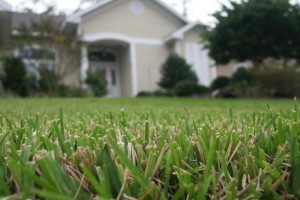
Image Credit: UF / IFAS
A beautiful lawn can add substantial value to a home. While providing an attractive setting for landscape ornamentals, a good lawn will reduce weed growth and prevent erosion. Selecting the proper grass for a specific location is a basic key to attaining these goals.
Five lawngrasses are commonly grown in Florida. Saint Augustine, Bahia, Centipede, Zoyia are most popular, while Carpet is used less often. This article will offer some facts which could assist the home gardener in choosing the best home turf species.
The most important thing to consider when selecting a lawngrass is the compatibility of that grass with the soil, climate, and growing conditions of a specific area. For example, along the coast a salt tolerant grass such as Saint Augustine should be planted. Attempting to grow Centipede or Bahia is asking for trouble. These grasses might be able to be established in a coastal location, but only with considerable expenditures of time and money. Likewise, if grasses are needed for a shaded lawn, plant Saint Augustine or Bahia, not Bermuda, which requires full sun.
After it is determined which lawngrasses will grow well in a given area, one should be chosen that is able to be managed properly. No lawngrass is maintenance free, but some types do require more care than others. For example, Bermuda produces the most beautiful lawns, but only if it’s heavily fertilized, frequently mowed, and kept free of pests and diseases. If a high level of maintenance cannot be provided, it would be wise to plant a low care grass, such as Bahia, or Centipede. Saint Augustine is not difficult to maintain, but thatch and chinch bugs are common problems.
The amount of water a particular grass requires is another consideration. Bahia has excellent drought tolerance Saint Augustine ranks second and Centipede ranks third.
In recent year, dramatic improvements in Zoysia grass have been made by turfgrass breeders. These improvements include insect resistance, accelerated establishment, and overall performance. Zoyiagrasses are adapted to a variety of soil types and have good tolerance to shade, salt, and traffic. They provide and extremely dense sod that resist weed invasion, but certain pest can be problematic.
Out of all Florida Lawngrasses, Bahia is most resistant to pests. It’s the best choice for landscapes heavily infested with nematodes. Saint Augustine also has good nematode tolerance, but chinch bugs are a serious threat to this grass. While it may be severely damaged by nematodes, Centipede has few other pest problems, providing it is not fertilized to heavily. Bermuda is plagued by many problems, in fact, it’s particularly impossible to grow this grass without a continuous control program to cope with nematodes, insects, and diseases.
A a number of good lawngrasses grow well in Florida, but each has certain advantages and disadvantages as well as specific cultural requirements. Area climate, landscape soil type, amount of home site shade and sun, and the degree of traffic by people and pets are important considerations when choosing home lawn truf types.
Information was provided by J. Bryan Unruh, Associate Center Director and Professor, West Florida Research and Education Center, Institute of Food and Agricultural Science, Jay, Florida.
Also, feel free to contact your local county extension agent or refer to these UF / IFAS publications on trufgrass selection.
For more information on choosing a lawngrass contact the author Roy Lee Carter, County Extension Director – Gulf County Florida, at
639-3200.







